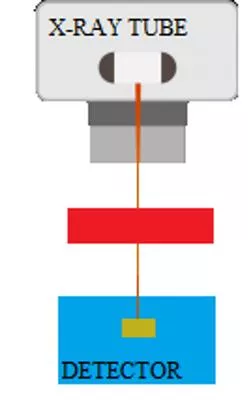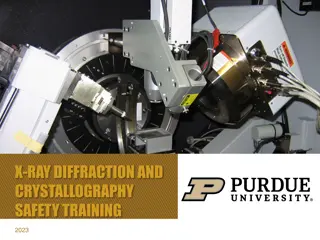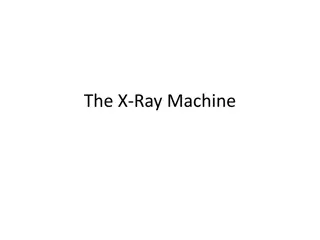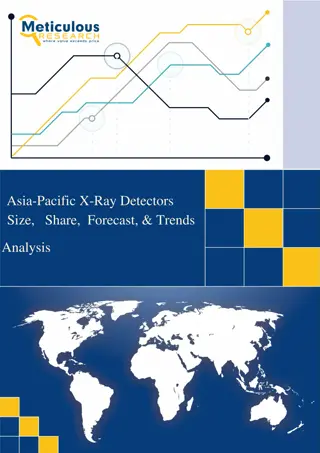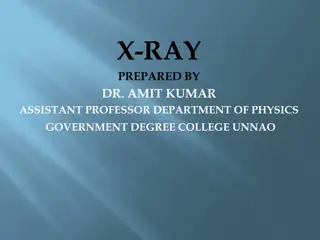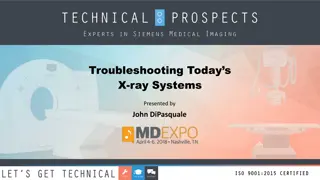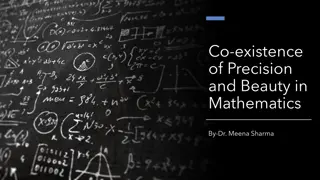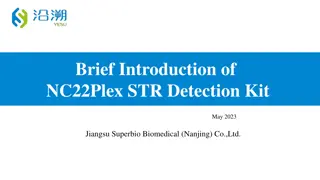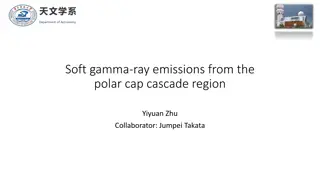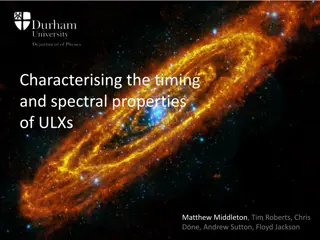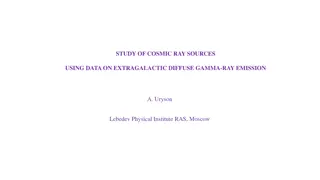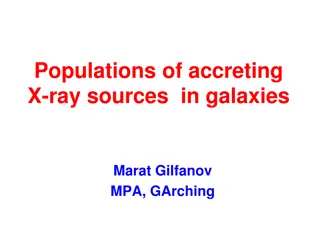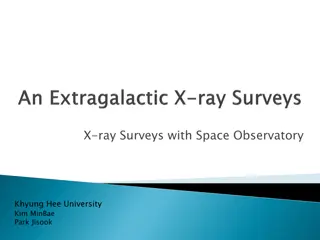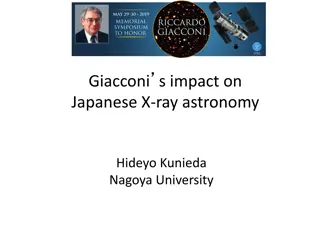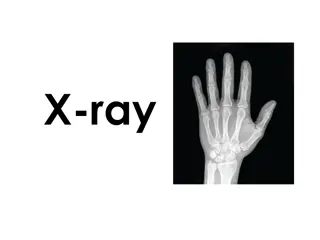Development of High-Precision X-Ray Detection Systems
This study focuses on the development of energy-resolved X-ray detectors for contaminant detection, with a goal of creating room temperature spectroscopic imagers for X-ray imaging up to 150 keV. The project involves collaboration between research institutions and companies in Italy to achieve high-energy resolution and sub-millimeter spatial resolution in detecting contaminants.
Download Presentation

Please find below an Image/Link to download the presentation.
The content on the website is provided AS IS for your information and personal use only. It may not be sold, licensed, or shared on other websites without obtaining consent from the author.If you encounter any issues during the download, it is possible that the publisher has removed the file from their server.
You are allowed to download the files provided on this website for personal or commercial use, subject to the condition that they are used lawfully. All files are the property of their respective owners.
The content on the website is provided AS IS for your information and personal use only. It may not be sold, licensed, or shared on other websites without obtaining consent from the author.
E N D
Presentation Transcript
High Precision X-Ray Measurements 2023 19 23 June 2023, Laboratori Nazionali di Frascati, Italy Development of energy Development of energy- -resolved X contaminant detection: results from the AVATAR X project contaminant detection: results from the AVATAR X project resolved X- -ray scanners for ray scanners for A. Buttacavoli1*, F. Principato1, G. Gerardi1, D. Cascio1, G. Raso1, V. Taormina1, M. Bettelli2, A. Zappettini2, S. Zanettini3, G. Bertuccio4, F. Mele4, J. Quercia4and L. Abbene1 1Department of Physics and Chemistry-E. Segr , University of Palermo, Italy 2IMEM/CNR, Parma, Italy 3due2lab s.r.l, Reggio Emilia, Italy 4Politecnico di Milano, Como, Italy *corresponding author: antonino.buttacavoli@unipa.it
Motivations Goal: Development of room temperature spectroscopic imagers for X-ray imaging up to 150 keV. AVATAR X Project (MUR) Energy-resolved X-ray scanners for food inspections Department of Physics and Chemistry (DiFC), University of Palermo (Italy) (L. Abbene) Collaboration IMEM-CNR, Parma (Italy) (A. Zappettini) Politecnico di Milano, (G. Bertuccio) Due2lab company, Italy (N. Zambelli)
Proposed Detection Systems Front-end electronics with the preamplifier (CSP) stage Digital Readout Electronics for Pulse Shape and Height Analysis (PSHA) CZT linear array detectors Requirements Room temperature operation Energy resolution < 3 keV at FWHM at 60 keV Sub-millimetre spatial resolution (< 0.5 mm)
DETECTORS AND ELECTRONICS
The Detectors Detectors are fabricated at IMEM-CNR (Parma, Italy) and by due2lab s.r.l (Reggio Emilia, Italy). CZT crystals (10.4 x 3 x 1 mm3) grown by using the Boron Oxide Encapsulated Vertical Bridgman (B-VB) growth technique and gold electroless contacts. A. Zappettini et al., J. Cryst. Growth 307 (2007) 283 Linear arrays with pixel pitch of 225 m. Inter-pixel gap of 25 m. Intermediate guard-ring to minimize charge sharing.
B-VB CZT Detectors Physical properties of B-VB CZT detectors Low leakage currents Good electron charge transport properties High bias voltage operation (> 7000 V/cm) L. Abbene, et al. J. Synchrotron Rad. (2020) 27 (2), 319.
Front-end Electronics Hybrid charge sensitive preamplifiers developed at University of Palermo Front-end preamplifier stage (no analog pulse shaping). electronics with ENC < 100 electrons. Resistive-feedback circuit with a decay time of 20 us.
Digital Electronics Digital Pulse Processing (DPP) electronics. 8 digitizers (100 MHz) with 32 channels (modified version of CAEN DT5724, CAEN S.p.A., Italy). Custom Firmware based on a DPP strategy developed at DiFC (University of Palermo). L. Abbene, et al. J. Synchrotron Rad. (2018) 25 (1), 257.
Digital Pulse Processing Digital Real-Time Pulse Shaping by using the Single Delay Line (SDL) and Trapezoidal filtering. Outputs (i) the arrival time (i) the pulse height (energy) (i) the pulse time width and the peaking time (shape) The system also allows the acquisition of the CSP waveforms for quick look or off-line analysis.
SPECTROSCOPIC RESULTS
Energy Spectra from Anode Pixels 400 241Am source T = 20 C 350 B-VB CZT Detector 300 1 mm thick 250 Counts 4.5% (2.7 keV) 200 FWHM at 59.5 keV 150 100 50 0 0 10 20 30 40 Energy (keV) 50 60 70 80 90 100 300 B-VB CZT Detector 57Co source T = 20 C 1 mm thick 250 200 Counts - 700 V 150 4.4% (5.4 keV) FWMH at 122.1 keV 100 50 0 0 20 40 60 80 100 120 140 160 180 200 220 240 Energy (keV)
Energy Spectra from internal guard-ring 0.05 109Cd source B-VB CZT Detector T = 20 C 0.018 1 mm thick T = 20 C 0.04 241Am source 0.016 Relative Counts 0.014 B-VB CZT Detector 0.03 1 mm thick Relative Counts 0.012 0.010 0.02 16 % (9.5 keV) 0.008 FWHM at 59.5 keV 0.006 0.01 0.004 0.00 0.002 0 5 10 15 20 Energy (kev) 25 30 35 40 45 50 0.000 0 10 20 30 40 Energy (keV) 50 60 70 80 90 100 0.010 B-VB CZT Detector 57Co source T = 20 C 0.009 1 mm thick 0.008 0.007 Relative Counts 0.006 0.005 0.004 0.003 0.002 0.001 0.000 0 20 40 60 80 100 120 140 160 180 200 220 240 Energy (keV)
Energy Spectra from Cathode 0.010 0.030 241Am source T = 20 C 109Cd source T = 20 C 0.025 0.008 Relative Counts Relative Counts 0.020 0.006 0.015 0.004 0.010 0.002 0.005 0.000 0.000 0 10 20 30 40 Energy (keV) 50 60 70 80 90 100 0 5 10 15 20 Energy (keV) 25 30 35 40 45 50 0.010 57Co source T = 20 C 0.009 0.008 0.007 Relative Counts 0.006 0.005 0.004 0.003 0.002 0.001 0.000 0 20 40 60 80 100 120 140 160 180 200 220 240 Energy (keV)
Spectroscopic Correction with Cathode/Anode Pulses 1.4 500 57Co source 122 keV Photopeak 1.2 Raw After DOI Correction 57Co source 450 Cathode/Anode Ratio 1.0 400 0.8 0.6 350 Relative Counts 0.4 300 2.5 % (3 keV) 0.2 FWHM at 122.1 keV 250 0.0 100 105 110 115 120 125 130 135 140 200 Anode Energy (keV) 4.4 % (5.4 keV) 1.4 150 FWHM at 122.1 keV 57Co source 122 keV Photopeak 1.2 100 Cathode/Anode Ratio 1.0 50 0.8 0 100 105 110 115 120 Energy (keV) 125 130 135 140 145 150 0.6 0.4 0.2 DOI corrected events 0.0 100 105 110 115 120 125 130 135 140 Anode Energy (keV)
PRELIMINARY RESULTS WITH A NEW ASIC
Spectroscopic Performance with a new ASIC SIRIO ASIC Preamplifier Stage Technology: CMOS 0.35 m Conversion gain: 40 mV/fC ENC (without detector) 3.2 el. r.m.s. Rise-time (without detector): <10 ns F. Mele, et al. IEEE TNS (2021) 68, 379-383. Ultra-high resolution at room temperature very close to the Fano Noise (0.4 keV at 60 keV)!
CHARGE SHARING MEASUREMENTS
Charge Sharing Results Time coincidence events between a pixel with all adjacent pixels and guard-ring (simulating a pixel layout) Shared events of 49 % with inter-pixel gap of 25 m. For comparison, shared events of 60 % with inter-pixel of 50 m.
Charge Sharing Results Time coincidence events between a pixel with the two adjacent pixels (linear array approach) Shared events of 36 % with collimator and guard-ring (linear array approach).
Charge Sharing Results Time coincidence events between a pixel with the two adjacent pixels (linear array approach)
RESULTS FROM ENERGY-RESOLVED IMAGES
The Phantom X-ray scanning with Ag-target X-ray tube (50 kV) Scanned area ?? ?? ?? ?? ?? ????= =
Photon Counting Images and Charge Sharing X-ray scanning with Ag-target X-ray tube (50 kV) G-CSD Image (after CSD with the internal guard-ring) Raw Image (with charge sharing) CNRsteel = 11 CNRplastics = 5 CNRsteel = 6 CNRplastics = 1 CSD Image (after CSD) CNRsteel = 11 CNRplastics = 6
Energy-Resolved X-ray Images New Technique: Window-Based Energy Selecting X-ray Imaging Taormina et al. 21 June 2023 5:10 pm Session: X-ray detectors 3 This conference A. Buttacavoli et al., Sensors Vol 23, Issue 6 (2023) 3196
Energy-Resolved X-ray Images New Technique: Window-Based Energy Selecting X-ray Imaging Taormina et al. 21 June 2023 5:10 pm Session: X-ray detectors 3 This conference A. Buttacavoli et al., Sensors Vol 23, Issue 6 (2023) 3196
Conclusions and Ongoing Activities B-VB CZT linear array detectors with good room temperature performance (FWHM < 3 keV at 60 keV) are developed. Inter-pixel gap of 25 m allows the reduction of charge sharing and charge losses. Ultra-high energy resolution (0.6 keV FWHM at 60 keV) was obtained with a new ASIC, opening exciting activities for spectroscopic and imaging enhancements. A new energy-resolved approach, termed window-based energy selecting, was developed and excellent CNR enhancements in X-ray images were obtained, if compared with photon counting and other energy-resolved techniques; 20
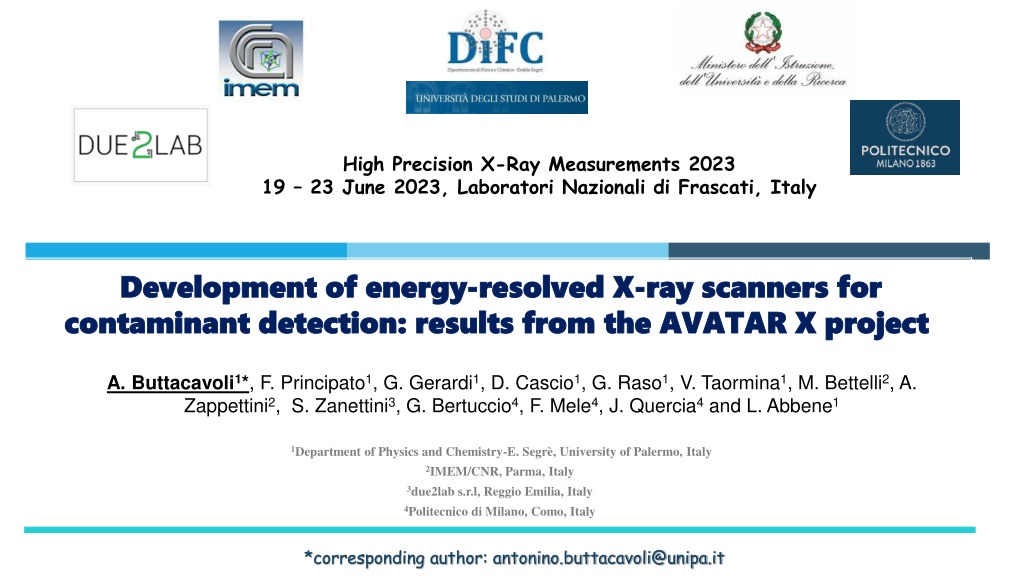
 undefined
undefined


















